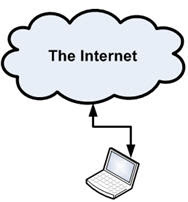Imagine a CEO of a company large enough responsibility to ensure that all employees are equipped with the proper software and hardware they need to perform their duties. It is not enough to simply buy workstations because it's just a piece of the puzzle, you must also purchase software and licenses for your employees the tools they need to do their job. Every time you hire a new employee, make sure you have the same tools at their disposal - either by buying more, or in the case of software, confirms that the license covers a different user.
This is where cloud computing comes - when you think about the needs of your company. You need a way to increase capacity or add capabilities on the fly without investing in new infrastructure or permits, or employee training time and money to spend. So what is cloud computing? The definition depends on who you ask. Certain narrowly defined as virtual servers on the Internet, while others argue for a broader definition, that everything your organization uses outside of your firewall is "in the cloud." Best be described as a subscription or pay-as-you-go service that allows your IT to extend existing capabilities on demand and in real time.

With a cloud of everything a user needs is a client device like a laptop or desktop, smartphone, tablet or other device equipped with a Web browser on a cloud system access via World Wide Web . The user will generally log into the cloud created by the Web browser protocols. The cloud gives the workload of processing the application or data that the user is interested, with the result displayed on the client device. The most common piece of software cloud at the moment seems to be Google Apps. Mail, word processing and other functions are all done on the server side and all the data is stored in the cloud, where the user needs only one way to open it.
Return to your role as manager, to the cloud you have to offer? There are many advantages to adopting a cloud architecture of your organization, both physical and otherwise. In terms of software licenses, for example, offers two advantages, the cloud can scale up and down on your consumption, while not having to carefully keep track of your license compliance guidelines. Hardware costs are another important consideration for any organization, especially when it comes to applications you need to run your business. No need to plan the peak loads and the architect must be able to manage your hardware. With the cloud computing model, you only need to make additional charges if you need it, and save money if you do not. Another area of savings is the maintenance time and costs involved in deploying hardware upgrades and software for applications is greatly reduced by the cloud computing model.
Some of the major Internet players like Amazon and Google, and some of the largest telecoms, including Verizon and AT & T making substantial investments in cloud computing, this region is poised for significant growth in the coming years.
0 comments:
Post a Comment